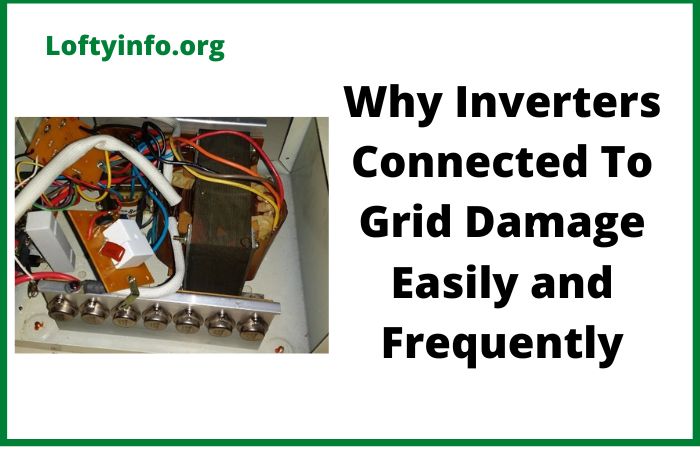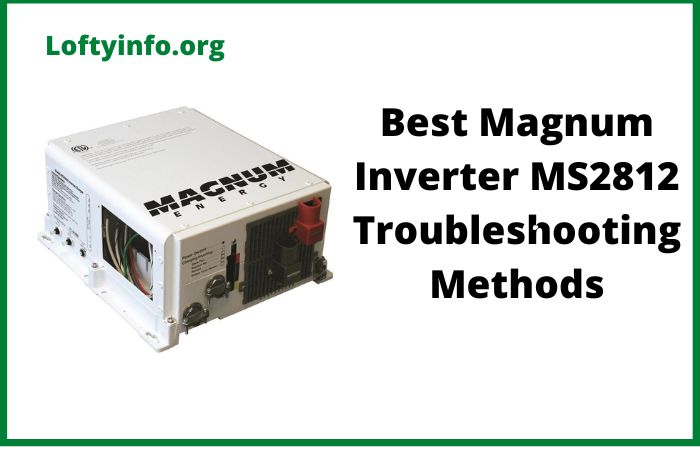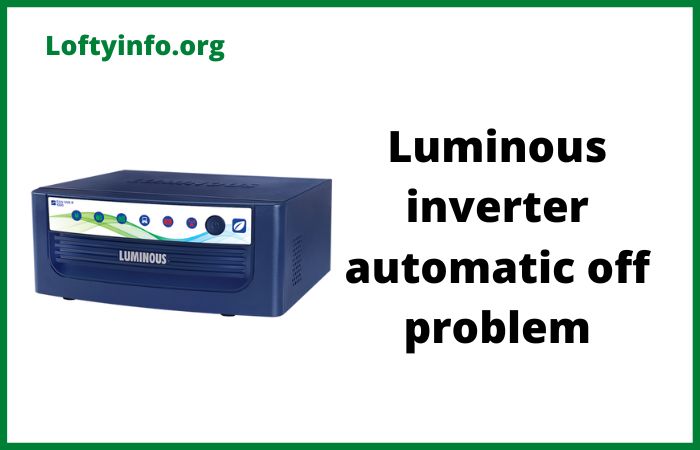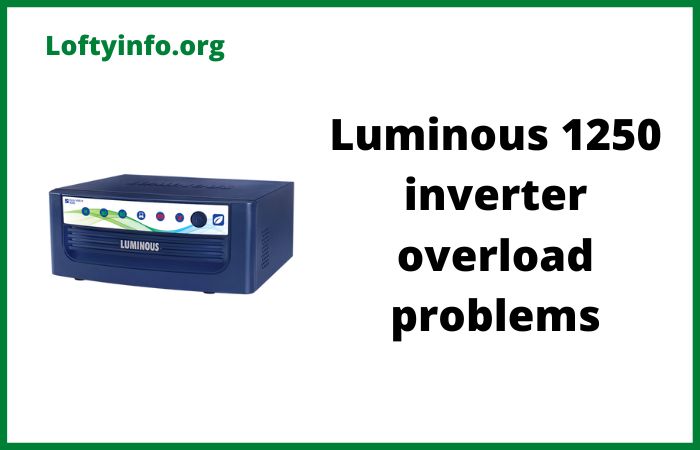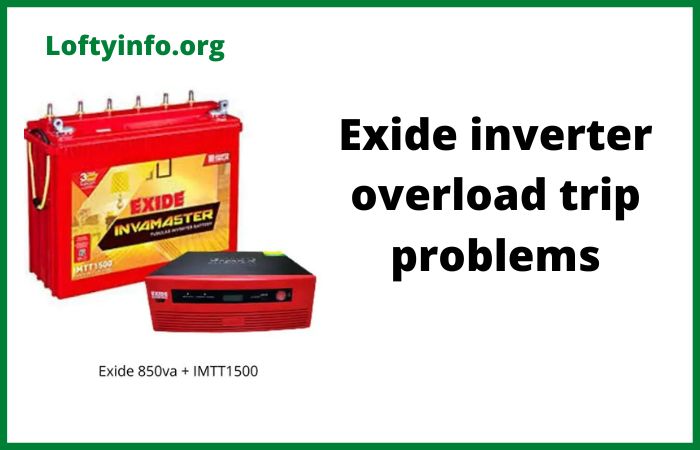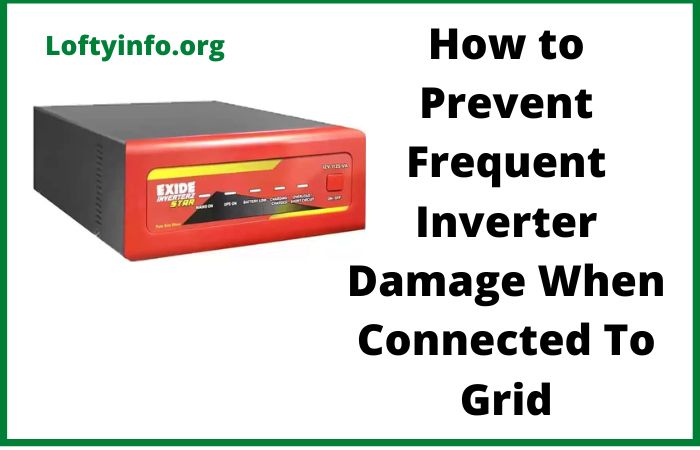Why Inverters Connected To Grid Damage Easily and Frequently
The rapid expansion of renewable energy systems has brought grid-connected inverters into the spotlight as critical components in modern power infrastructure.
These devices serve as the bridge between solar panels or other renewable energy sources and the electrical grid, converting direct current into alternating current that can be used by homes and businesses or fed back into the utility network.
Many system owners and installers have observed a troubling pattern in which inverters connected to grid damage easily and frequently compared to their standalone counterparts.
This phenomenon has significant financial implications as inverter replacement and repairs can account for a substantial portion of system maintenance costs over the lifecycle of a renewable energy installation.
Understanding the root causes of premature inverter failure is essential for system designers, installers and owners who want to maximize their investment in renewable energy technology.
While inverters are designed to last between ten to fifteen years on average, many units fail well before reaching their expected lifespan.
The reasons behind this accelerated degradation are multifaceted, involving electrical stress, environmental factors, component quality and operational conditions that are often underestimated during the planning phase.
By examining these factors in detail, we can develop better strategies for protecting these vital components and ensuring the long-term reliability of grid-connected renewable energy systems.
Why Inverters Connected To Grid Damage Easily and Frequently
1) Voltage Fluctuations and Grid Instability
The electrical grid is not as stable as many people assume.
Voltage levels fluctuate constantly throughout the day as demand rises and falls.
Industrial loads switch on and off and power generation sources adjust their output.
In many regions particularly in developing countries and rural areas, these fluctuations can be quite severe with voltage swings of plus or minus ten percent or more being relatively common.
Grid-connected inverters must constantly adapt to these changing conditions by adjusting it’s output to match the grid voltage and frequency while maintaining synchronization.
This continuous adjustment places significant stress on the inverter’s internal components particularly the switching devices and control circuitry.
Every time the grid voltage changes, the inverter must modulate its output which causes the power electronics to heat up and cool down repeatedly.
This thermal cycling is one of the primary mechanisms of component degradation in inverters.
The situation becomes even more challenging during voltage sags where the grid voltage drops significantly for brief periods.
During these events, the inverter must draw more current to maintain its power output which can push components beyond their rated specifications and accelerate wear.
Voltage spikes caused by lightning strikes, switching operations at substations or the sudden disconnection of large loads can send transient overvoltages through the grid.
While inverters are equipped with protection circuits designed to handle these events, repeated exposure to voltage transients gradually degrades the protective components themselves, eventually leading to failure.
In areas with particularly unstable grids, inverters may experience thousands of these stress events annually dramatically shortening their operational lifespan.
2) Harmonic Distortion and Power Quality Issues
Modern electrical grids carry not just the fundamental fifty or sixty hertz alternating current, but also a complex mixture of harmonic frequencies generated by non-linear loads such as computers, variable frequency drives, LED lighting and other electronic devices.
These harmonics superimpose on the fundamental waveform, creating a distorted voltage and current pattern that inverters must work with.
When inverters connected to grid damage easily, harmonic distortion is often a contributing factor that goes unrecognized.
Harmonic currents cause additional heating in the inverter’s components because they increase the effective current flowing through the device without contributing to useful power transfer.
The inverter’s filter capacitors, in particular, are vulnerable to harmonic-induced stress.
These capacitors must handle higher ripple currents when harmonics are present, which accelerates their aging process.
Electrolytic capacitors commonly used in inverter designs have a finite lifespan that is directly related to their operating temperature and the ripple current they must handle.
High harmonic content can reduce capacitor life by fifty percent or more compared to operation with a clean sinusoidal waveform.
The inverter’s control algorithms must also work harder to maintain synchronization with a distorted grid waveform.
This requires faster switching operations and more complex modulation strategies, which increase switching losses and generate additional heat within the power electronics.
Over time, this elevated thermal stress contributes to the degradation of semiconductor junctions in the switching devices, increasing their on-resistance and further elevating operating temperatures in a destructive feedback loop.
In commercial and industrial settings where power quality is often poor due to the concentration of non-linear loads, inverter failure rates can be significantly higher than in residential applications.
3) Inadequate Thermal Management
Another reason why why grid connected inverters damage easily and frequently is due to excessive heat.
Heat is the silent killer of electronic components and inverters generate substantial amounts of it during normal operation.
The conversion process from DC to AC is not perfectly efficient and the energy lost in the conversion process manifests as heat that must be dissipated to prevent component damage.
Most inverters operate at efficiency levels between ninety-five and ninety-eight percent which sounds impressive until you consider that a five-kilowatt inverter operating at ninety-six percent efficiency is still generating two hundred watts of waste heat that must be removed.
Many inverter failures can be traced back to inadequate thermal design or poor installation practices that compromise the cooling system.
Inverters installed in direct sunlight, in poorly ventilated enclosures or in locations with high ambient temperatures face a constant battle against overheating.
For every ten-degree Celsius increase in operating temperature above the design specification, the expected lifespan of electronic components roughly halves following what engineers call the Arrhenius equation.
This means that an inverter running consistently hot due to poor thermal management could fail in five years instead of ten.
The thermal management challenge is compounded by dust and debris accumulation on cooling fins and fan intakes.
In dusty environments, a layer of insulating dirt can build up on heat sinks dramatically reducing their effectiveness.
Cooling fans themselves are mechanical components with limited lifespans and when they fail, the inverter quickly overheats.
Many inverter designs rely on natural convection cooling, which requires careful attention to installation orientation and clearance around the unit.
When installers fail to follow these guidelines, perhaps mounting an inverter too close to a wall or installing it in a horizontal orientation when vertical mounting is specified, the thermal performance suffers significantly and the inverter connected to the grid may damage more easily than expected.
4) Component Quality and Design Compromises
The competitive pressure in the renewable energy market has driven inverter prices down dramatically over the past decade.
While this has made solar and wind power more economically attractive, it has also incentivized manufacturers to cut costs wherever possible.
One of the most common areas for cost reduction is in component selection where manufacturers may choose less expensive capacitors, inductors or switching devices that barely meet the specification requirements rather than including generous safety margins.
Electrolytic capacitors are a particular weak point in many inverter designs.
These components are essential for smoothing voltage ripples and providing energy storage, but they have a limited operational life that depends heavily on temperature and voltage stress.
Budget inverter designs often use capacitors rated for only a few thousand hours of operation at their maximum rated temperature.
In real-world conditions, this translates to premature failure as the capacitors dry out or develop internal shorts.
Higher-quality designs use film capacitors or longer-life electrolytic capacitors that can significantly extend inverter lifespan but these components cost more and reduce profit margins.
Similarly, the power semiconductors that perform the actual DC to AC conversion are available in a wide range of quality levels.
Premium devices feature lower on-resistance, faster switching speeds and better thermal characteristics but they cost substantially more than basic equivalents.
Some manufacturers use undersized switching devices that operate close to their maximum ratings during normal operation, leaving little margin for the inevitable stress events that occur in real-world grid connections.
When these devices are pushed beyond their limits by a voltage transient or an unusually hot day, they fail catastrophically, taking other components with them.
The printed circuit boards themselves can be a source of reliability issues.
High-quality inverters use multi-layer boards with heavy copper traces, conformal coating to protect against moisture and high-temperature materials that resist degradation.
Economy inverters may use thinner boards with minimal copper, no protective coating and materials that become brittle or delaminate when exposed to thermal cycling.
These design compromises might not be apparent from the outside but they significantly impact long-term reliability.
5) Grid Connection Requirements and Anti-Islanding Protection
Grid-connected inverters must comply with strict utility interconnection standards that are designed to protect both the grid infrastructure and utility workers.
These requirements include anti-islanding protection, which forces the inverter to shut down within a fraction of a second if it detects that the grid has been disconnected.
This safety feature prevents the inverter from continuing to energize power lines that workers might assume are dead but it also subjects the inverter to frequent stress cycles.
The anti-islanding detection algorithms work by actively perturbing the voltage and frequency at the point of interconnection and monitoring the grid’s response.
If the grid is present, it acts as a strong voltage source that resists these perturbations.
If the grid has disappeared, the inverter’s perturbations will cause measurable changes in voltage and frequency, triggering a shutdown.
This constant probing process requires rapid adjustments to the inverter’s output, which increases switching activity and generates additional heat and electrical stress.
Furthermore, when the grid does experience an outage, the inverter must detect this condition and disconnect almost instantaneously, then remain disconnected until it verifies that the grid has returned to normal parameters for a specified waiting period.
This rapid shutdown process can create voltage and current transients within the inverter itself, particularly if it occurs while the inverter is operating at high power levels.
Repeated connection and disconnection cycles, which might occur during periods of grid instability or during utility maintenance work, gradually degrade the inverter’s internal relay or switching components.
Some grid-connected systems also require the inverter to provide voltage support or reactive power compensation, forcing the device to operate in modes that differ from its most efficient operating point.
These ancillary services, while beneficial to grid stability, place additional stress on inverter components and contribute to accelerated aging.
The cumulative effect of meeting all these grid requirements is that inverters connected to the grid experience operational stresses that off-grid inverters never encounter.
6) Environmental and Installation Factors
Another reason why inverters connected to grid damage easily and frequently is due to the environment where they are installed.
The physical environment in which an inverter operates has a profound impact on its reliability and lifespan.
Moisture is particularly destructive to electronic equipment, and inverters installed in humid climates or coastal areas face constant exposure to water vapor that can infiltrate the enclosure.
Once inside, moisture facilitates corrosion of electrical connections, degrades insulation materials, and can cause short circuits across circuit board traces.
Salt-laden air in coastal environments is especially corrosive, attacking metal components and accelerating degradation.
Temperature extremes present another challenge.
While hot environments are problematic for the reasons already discussed, cold temperatures can also cause issues.
Many inverters use electrolytic capacitors that have reduced capacitance at low temperatures, which can affect the inverter’s performance and potentially cause it to shut down or operate inefficiently until it warms up.
The thermal expansion and contraction that occurs as equipment cycles between day and night temperatures also creates mechanical stress on solder joints and component leads, eventually causing fatigue failures.
Installation quality is another critical factor that often goes overlooked. Improperly sized wiring can cause voltage drops that force the inverter to draw higher currents, increasing losses and heat generation.
Loose electrical connections create high-resistance junctions that generate localized heating, potentially damaging terminals or internal components.
If the inverter is not properly grounded, it becomes vulnerable to damage from electrical surges and may also pose a safety hazard.
Poor workmanship during installation, such as overtightening cable glands and damaging seals or failing to properly secure the mounting bracket so that vibration can occur, all contribute to premature failure.
The orientation and location of the inverter also matter significantly.
Inverters should generally be mounted in shaded, well-ventilated locations with adequate clearance around all sides to facilitate cooling.
Installing an inverter inside a hot attic, in direct sunlight, or in a cramped utility closet with poor air circulation virtually guarantees a shortened lifespan.
Yet these installation mistakes are surprisingly common, made either out of ignorance or because more suitable locations would require longer cable runs or be less aesthetically pleasing.
7) Undersized or Improper System Design
The final major reason why grid-connected inverters fail prematurely relates to fundamental system design errors.
When inverters are selected without proper consideration of the actual operating conditions they will face, they may be chronically overstressed or operated outside their optimal range.
A common mistake is selecting an inverter that is too small for the connected solar array, forcing the device to operate at maximum capacity for extended periods during sunny days.
While it might seem economical to save money on a smaller inverter, this practice of “undersizing” can dramatically reduce the inverter’s lifespan by keeping its components at elevated temperatures and stress levels.
Conversely, grossly oversizing an inverter can also create problems. Inverters have minimum operating thresholds below which they cannot maintain synchronization with the grid or operate efficiently.
An oversized inverter may spend much of its time operating at low power levels where efficiency is poor and where the control algorithms struggle to maintain stable operation.
This can result in increased switching losses and erratic behavior that stresses components.
The DC voltage range of the solar array must also match the inverter’s input specifications.
If the string configuration produces voltages that are too high, even temporarily during cold, clear mornings when panel voltage peaks, the inverter’s input protection may repeatedly trigger or worse, the input stage may be damaged.
If the voltage is consistently too low, the inverter may struggle to boost it to the level needed for grid connection, operating inefficiently and generating excessive heat in the input stage.
Ground fault and arc fault detection systems, now required in many jurisdictions, add complexity to the inverter and can themselves become sources of nuisance tripping or malfunction.
If these systems are overly sensitive or improperly calibrated, they may cause the inverter to shut down unnecessarily, creating frequent power cycling that stresses components.
If they are not sensitive enough, they may fail to detect genuine faults, potentially allowing dangerous conditions to persist that could damage the inverter or create fire hazards.
The integration of battery storage systems with grid-connected inverters adds another layer of complexity and potential failure modes.
Hybrid inverters that must manage both solar input and battery charging/discharging cycles face substantially more complex control challenges and higher component stress than simple grid-tied inverters.
The additional power conversions required when energy flows from solar to battery to grid increase losses and heat generation, while the control algorithms must juggle multiple priorities simultaneously.
How to prevent frequent inverter damage when connected to grid
